Affiliate disclosure: This post may contain affiliate links. Please see our Privacy Policy.
Flower wines take the flavor and aroma of fresh edible flowers and incorporate them into a homemade wine with unforgettable flavor. I’ll walk you through how to make homemade wine from scratch, using any edible flower.
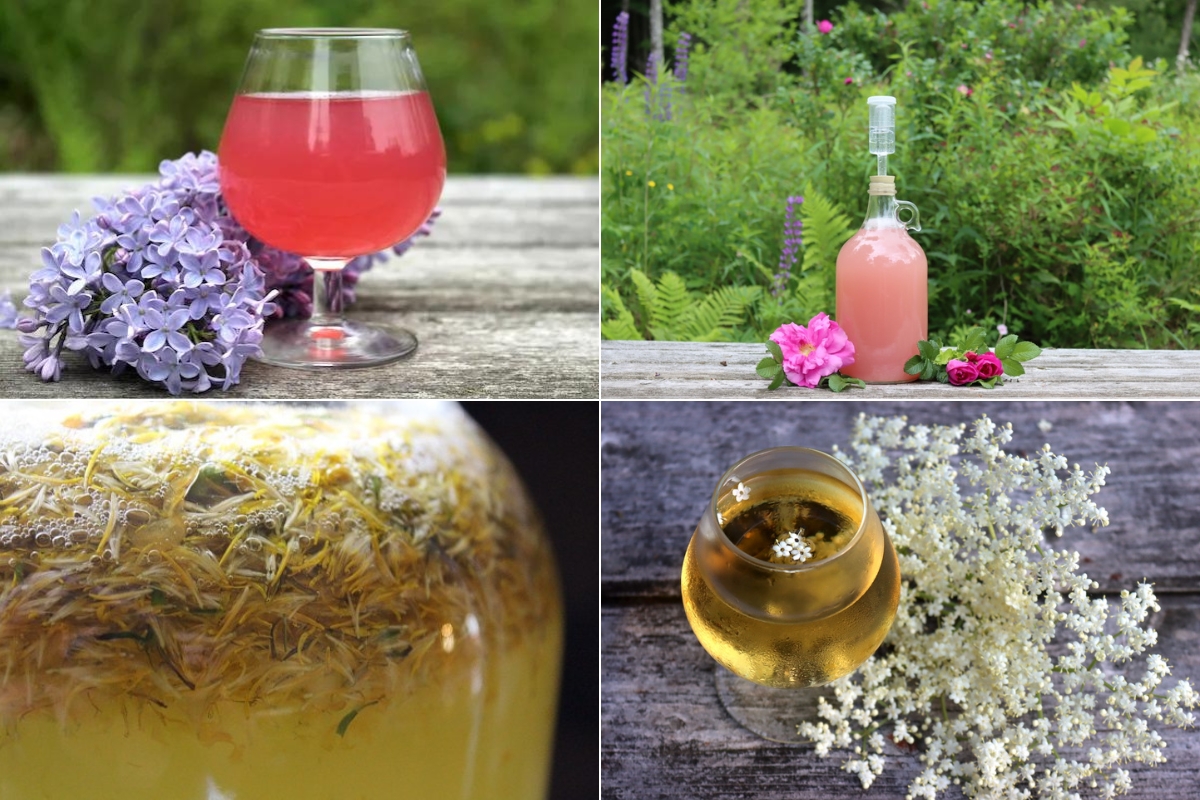
Table of Contents
- Ingredients for Flower Wines & Meads
- Equipment for Herbal Wines and Meads
- Making Flower Wines and Meads
- Infuse the Flowers
- Primary Fermentation
- Racking
- Secondary Fermentation
- Tasting and Adjusting
- Tertiary Fermentation (optional)
- Bottling
- Flower Wine & Mead Recipes
- Flower Wine (or Mead) Recipe
- Winemaking Recipes
- Mead Recipes
Summertime absolutely stunning here in Vermont, but it’s painfully short. We have a frost-free growing season of right around 100 days, which means that every last bit of summer splendor is packed in a short three-month period.
All of those beautiful flowers and their intoxicating aromas come out at once for a short bit, and I’m always looking for more ways to enjoy those summer moments a bit longer. We make flower jellies from many of the flowers here, but there’s only so much toast you can eat.
Flower wine, on the other hand, is perfect for sipping year-round, and it’s extra special when you’re snowed in during a long cold January.
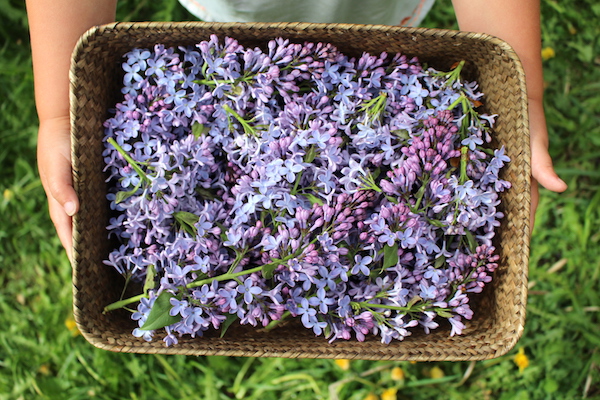
Once you’ve read through this guide, you should be able to craft a homemade wine or mead from any edible flower.
Since many edible flowers are also technically “herbs” with mild medicinal benefits, you might consider taking The Craft of Herbal Fermentation from the Herbal Academy of New England. They cover wine, mead, kombucha, lacto-ferments, and more in an easy-to-understand online course with plenty of recipes. All of the information discussed there would also apply to flower wines, as the processes are largely the same.
If you’re new to winemaking, I have a winemaking series that walks you through all parts of the winemaking process. If there’s something you don’t understand in this guide to making herbal wines, you can refer to any of these more in-depth guides:
- Beginners Guide to Making Fruit Wines, covering all the steps involved in winemaking of any kind (flower, herb, fruit or vegetable).
- How to Make Mead (Honey Wine) has all the instructions specific to making meads with honey (instead of wines with sugar).
- Equipment for Winemaking can be tricky, and this is a great place to start for new fermenters.
- Ingredients for Winemaking will help you understand everything that goes into a bottle.
- Yeast for Winemaking is surprisingly important, and the choice here will impact both the flavor and alcohol content of the finished wine.
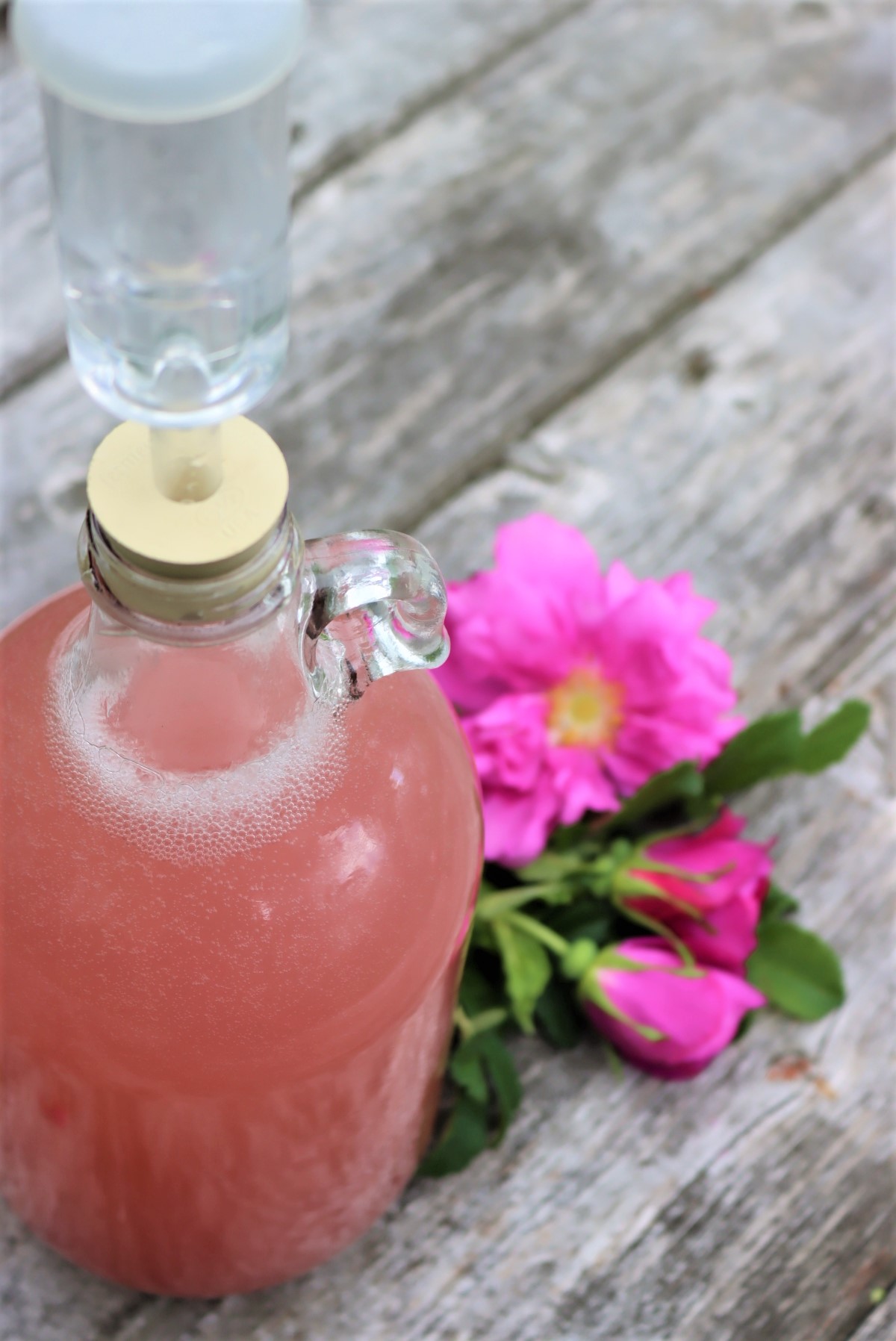
Ingredients for Flower Wines & Meads
When making a floral wine, the flowers are providing flavor, but you’ll also need sugar (or honey) to feed the yeast. You’ll also need a bit of acidity (which fruits have naturally, but flowers lack), and tannin to balance the wine. This usually comes in the form of lemon juice and strongly brewed black tea. (Or acid blend powder and tannin powder, if you’re a serious winemaker.)
Lastly, you’ll need a bit of yeast nutrient powder to feed the yeasts, as they can’t live on sugar alone, and they need the micro-nutrients that grapes would provide if you were making grape wine.
The basic recipe for a herbal or flower wine is as follows:
- 1 cup to 1 quart of edible flowers
- 5 to 6 cups sugar (or 3 lbs honey)
- 4 to 6 cups white grape juice, optional
- 1/4 cup lemon juice
- 1 tsp yeast nutrient
- 1/8 to 1/4 tsp wine tannin
- 1 packet wine yeast
I’d suggest referring to my guide on ingredients for winemaking if you’d like to learn more about why each ingredient is important and what you can substitute if you don’t have that specific thing on hand.
Still, I’ll cover the basics for each ingredient so you better understand the winemaking process.
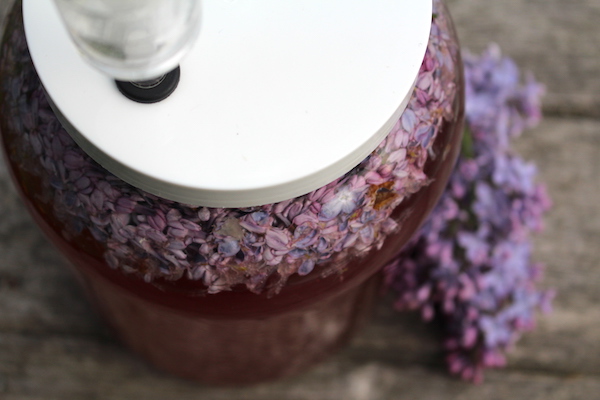
Flowers
The type and amount of flowers to use in winemaking depends on your goals. Some flowers have a delicate flavor, and you’ll need a good bit to really taste them. Other flowers are more intense, and you’ll want to be a bit more reserved.
As a general guideline, you need about 1 quart of cleaned flower petals to make a gallon of wine.
When you’re working with fragrant roses or lilacs, a quart is about right. With something more intense like lavender, you’ll want to go with about a cup of flower petals.
With delicately flavored dandelion blossoms, a quart is a minimum for a gallon of wine, and ideally, you’d have more like 6+ cups of cleaned petals. That is, if you have the patience to clean the petals. With many flowers, and dandelions included, you need to clean the blossoms to remove all the stem and sepal parts (or green parts) since they’re bitter, and you only use the fragrant petals.
We especially love dandelion wine, so we make it by the 5-gallon batch. That means a lot of cleaned dandelion petals!
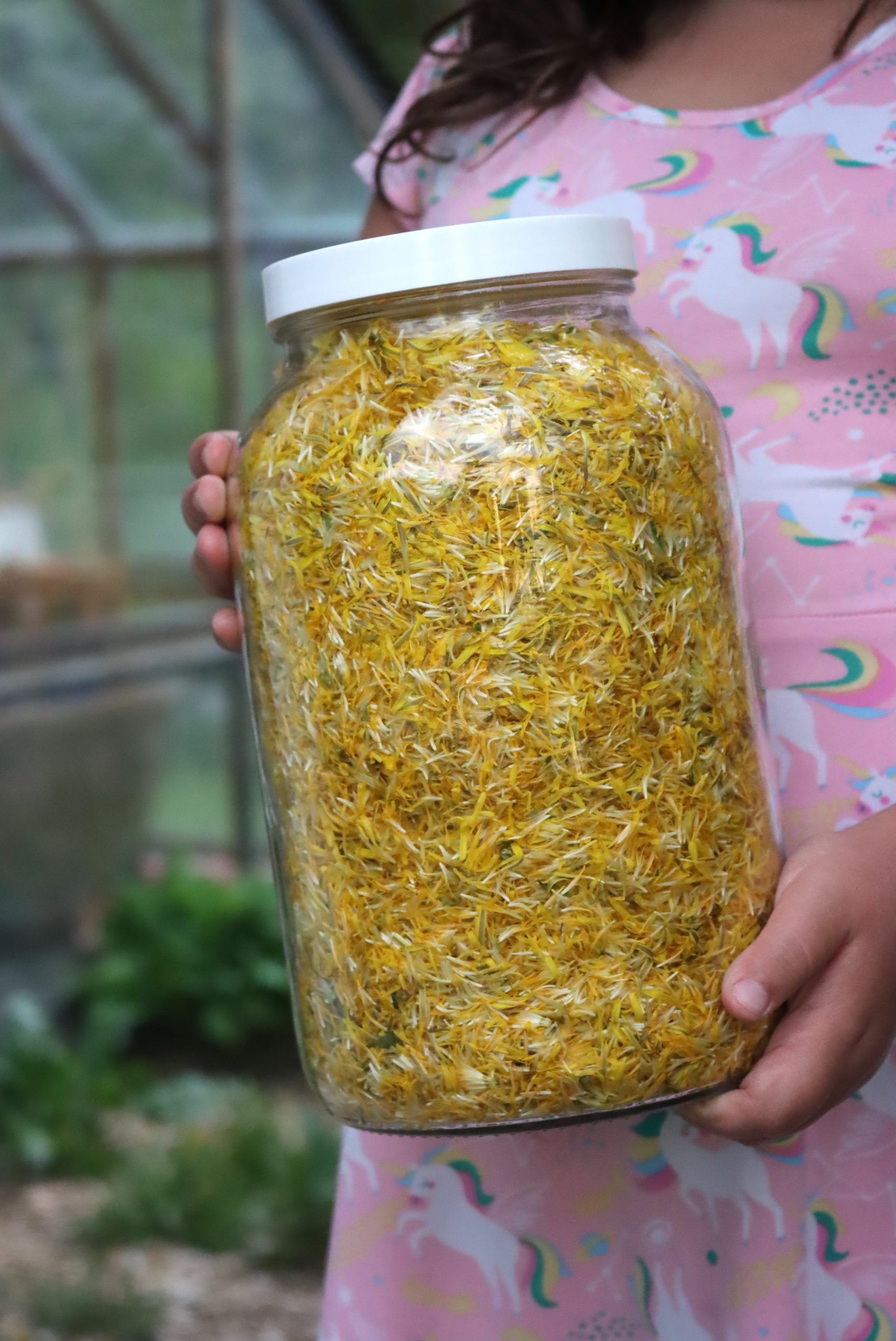
Sugar or Honey
Most wines require somewhere between 2 1/2 and 3 1/2 pounds of sugar or honey per gallon. We generally go with around 2 1/2 pounds if it’s sugar, and 3 pounds if it’s honey. You can always add more if your wine finishes too dry, but it’s harder to fix an overly sweet wine.
But believe it or not, the sweetness in a finished wine has less to do with the sugar, and more to do with the yeast.
Wine Yeast
The finished flavor and residual sugar will largely be determined by the alcohol tolerance of the yeast you’ve chosen. Yeast continues to work until they either run out of sugar and go dormant or reaches its alcohol tolerance and dies out.
If yeast has an alcohol tolerance of 14%, they’ll all die out when the wine reaches that ABV, and the rest of the sugar in the wine will stay as residual sugar, sweetening your glass.
The same recipe, but using yeast with an 18% alcohol tolerance will result in a dry wine, as the yeast will continue working much longer, resulting in more alcohol but less residual sugar.
Yeast plays a key role in developing a variety of flavors, such as fruity and floral notes, through the production of esters.
When selecting yeast for flower wines, there are several excellent options to consider, each offering different alcohol tolerances ranging from 12% to 18%. Below are some recommended strains:
- Red Star Cote des Blancs (Geisenheim Epernay): This yeast enhances the fruity character and sweetness in both red and white wines. It ferments slowly with minimal foam, which results in a longer fermentation period but preserves delicate aromas and volatile esters. Often used for apple wines, ciders, and sweet whites like Chardonnay, it has a lower alcohol tolerance—typically around 12-14%—especially at cooler fermentation temperatures, leaving behind more residual sugar. Its optimal fermentation temperature is between 64°F and 86°F.
- Lavin D47: Known for imparting a rich, fruity, and floral profile to wines, this strain adds complexity with notes of tropical fruit and citrus. It has a moderate fermentation rate and may start slowly. With an alcohol tolerance of up to 15%, it thrives in temperatures between 59°F and 86°F.
- Lalvin K1-V1116: This yeast is reliable in challenging fermentation conditions, such as fluctuating temperatures or low nutrient environments. It’s particularly known for producing a higher concentration of fruity and floral esters compared to other strains. K1-V1116 is ideal for rejuvenating bland or underwhelming juices. It boasts a high alcohol tolerance of up to 18% and can ferment in a wide temperature range from 50°F to 95°F.
If you’re curious, you can read my guide to choosing wine yeast for more options.
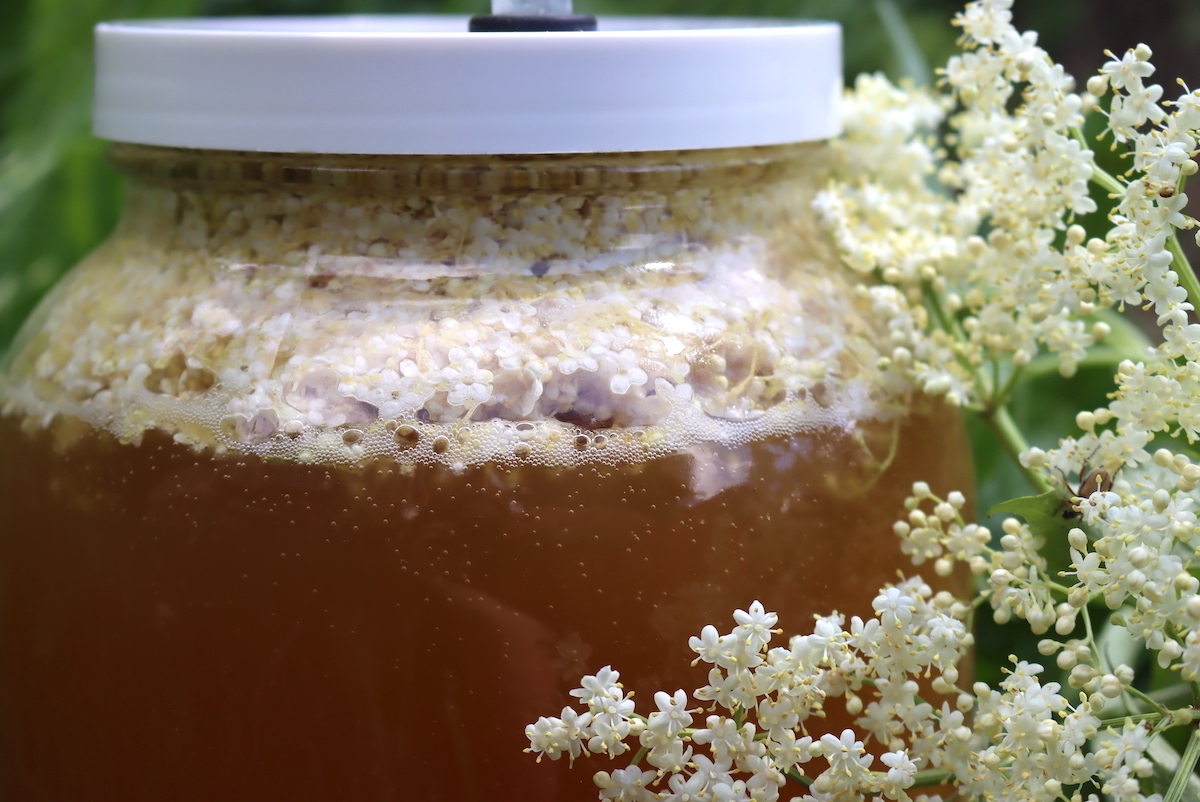
White Grape Juice
Wines made with just sugar and flowers tend to lack body, so using a bit of white grape juice can help to round out the body of the wine. If you’re making mead instead, the honey give the mead plenty of body naturally, so you don’t need the grape juice in that case.
If using grape juice in place of part of the water, reduce the total sugar by 1/2 to 1 cup.
Lemon Juice
Yeast requires a mildly acidic environment to complete their lifecycle, and you’d already have that naturally if you were making fruit wines. Flowers have a neutral pH, so you do need to add a little bit of citrus juice to drop the pH slightly.
Lemon juice is pretty neutral, and a bit of acidity helps balance the residual sugars in the finished wine.
You can also use lime juice or orange juice, as some recipes do, but they’re not as acidic as lemon, so you’ll need a bit more.
Sometimes, a bit of fruit juice like strawberry or blueberry is added for color. Lilacs don’t give up their color easily, so I add just a few blueberries into my lilac wine, and when it mixes with the acidic lemon juice, it turns a lovely pink color.
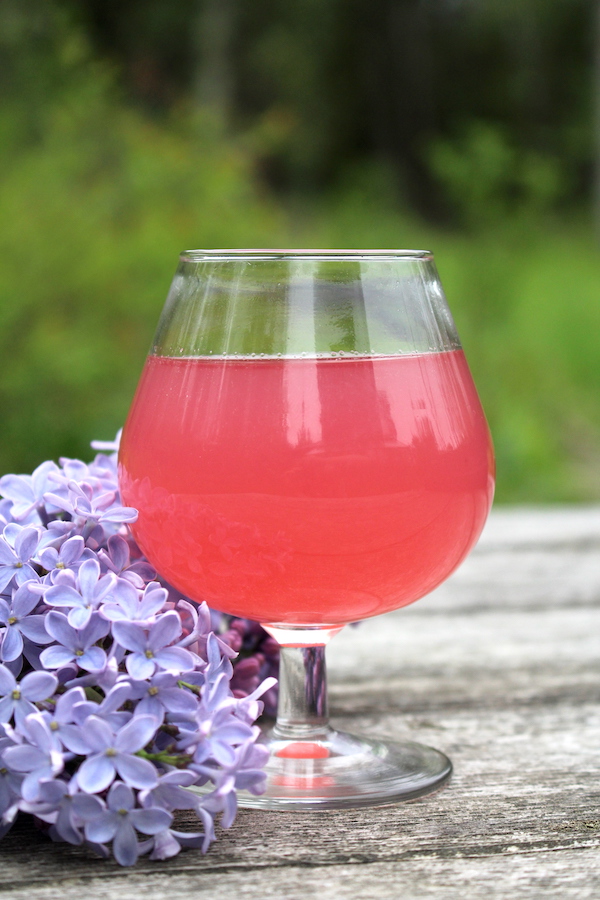
Yeast Nutrient
Grapes naturally have all the nutrients that the yeast needs to survive, but anytime you’re working with another fruit (or in this case, a flower), then you’ll need to feed the yeast more than just sugar.
This comes in the form of powdered yeast nutrient, which is usually added at a rate of 1 tsp per gallon. You can also add about 1/4 cup of raisins to the batch instead, but they will impact the flavor. For less impact, you can use golden raisins or sultanas.
Still, the most neutral choice is yeast nutrient powder. This is a specialty winemaking ingredient, and it’s different from the “nutritional yeast” that you see in health food stores.
Wine Tannin
Tannins give a wine a more rounded mouthfeel, which is important in flower wines that are often light-bodied.
Generally, tannins are added in the form of winemaking tannin powder, but you can also add tannins in a few other ways:
- 1 cup of strongly brewed black tea is about equal to 1/4 tsp tannin powder, but it’ll darken the wine
- 3-4 Grape leaves or currant leaves (unsprayed) also work
The most dependable method is tannin powder, and it won’t color your finished wine as some of the other methods will.
Equipment for Herbal Wines and Meads
Winemaking equipment can seem overwhelming, but it doesn’t have to be. Many of the tools you’ll “need” are actually optional, and you may already have suitable alternatives in your kitchen. My guide to winemaking equipment explains each item in detail and offers suggestions for using common kitchen supplies instead of specialized gear.
At a minimum, you’ll need the following equipment:
- One Gallon Glass Carboy (x2): These narrow-neck fermentation vessels, known as carboys, are used to hold the herbal wine during fermentation. You’ll need two, as you’ll transfer the wine to a clean container after 7-10 days of active fermentation to leave behind the sediment. These often come in kits with a rubber stopper and airlock.
- Rubber Stopper and Airlock: This setup acts as a one-way valve that lets carbon dioxide escape while keeping outside contaminants from entering the fermentation vessel, thus preventing the wine from turning into vinegar.
- Brewing Siphon: This tool helps you transfer the wine between containers and is also used when bottling.
- Wine Bottles: For long-term storage, wine bottles are the best choice. While beer bottles or flip-top Grolsch bottles can work for short-term storage, wine bottles provide a better seal for preserving your herbal wine.
- Bottle Corker: If you’re using wine bottles, you’ll need a corker to seal them. Be sure to use clean, new corks when bottling your wine.
- Brewing Sanitizer: A one-step, no-rinse sanitizer is essential for cleaning and sanitizing all your equipment before use to ensure everything is free from any unwanted bacteria or residues.
With flower wines, I tend to use a wide-mouth fermenter for the primary, since the flower petals can clog the narrow neck of a traditional carboy and be a mess to clean.
Making Flower Wines and Meads
The process for making flower wine can be adapted for any edible flower. While the exact amount of flower material will vary depending on the type you’re using, the overall process remains largely the same.
When making mead, you’ll substitute honey for sugar, and the fermentation will typically take longer since yeast converts honey into alcohol at a slower rate than sugar.
Infuse the Flowers
I prefer a cold infusion method for flower petals, which helps preserve their delicate, aromatic flavors. This method can be tricky in a narrow-neck carboy, so I typically start the fermentation in a wide-mouth fermenter. For example, when making dandelion wine, I find that the petals can sometimes clump together and block the airlock, which can cause fermentation issues and make a mess.
To start, add the flowers to the fermenter. Bring water and sugar to a boil in a separate pot, stirring until the sugar is fully dissolved. Let the mixture cool down completely before pouring it into the fermenter with the flowers.
You’ll also add any other ingredients, like yeast nutrients, lemon juice, and tannin powder—except for the yeast.

Add Yeast
Yeast should be added right before fermentation begins, and it’s important to rehydrate it in plain water first. Adding dry yeast directly into the sugary mixture can cause a “shock” to the yeast. Make sure the mixture is at room temperature before introducing the yeast (if you’ve heated the water for the infusion, ensure it cools down first).
The fermentation should begin within 24 to 72 hours, with the mixture actively bubbling.
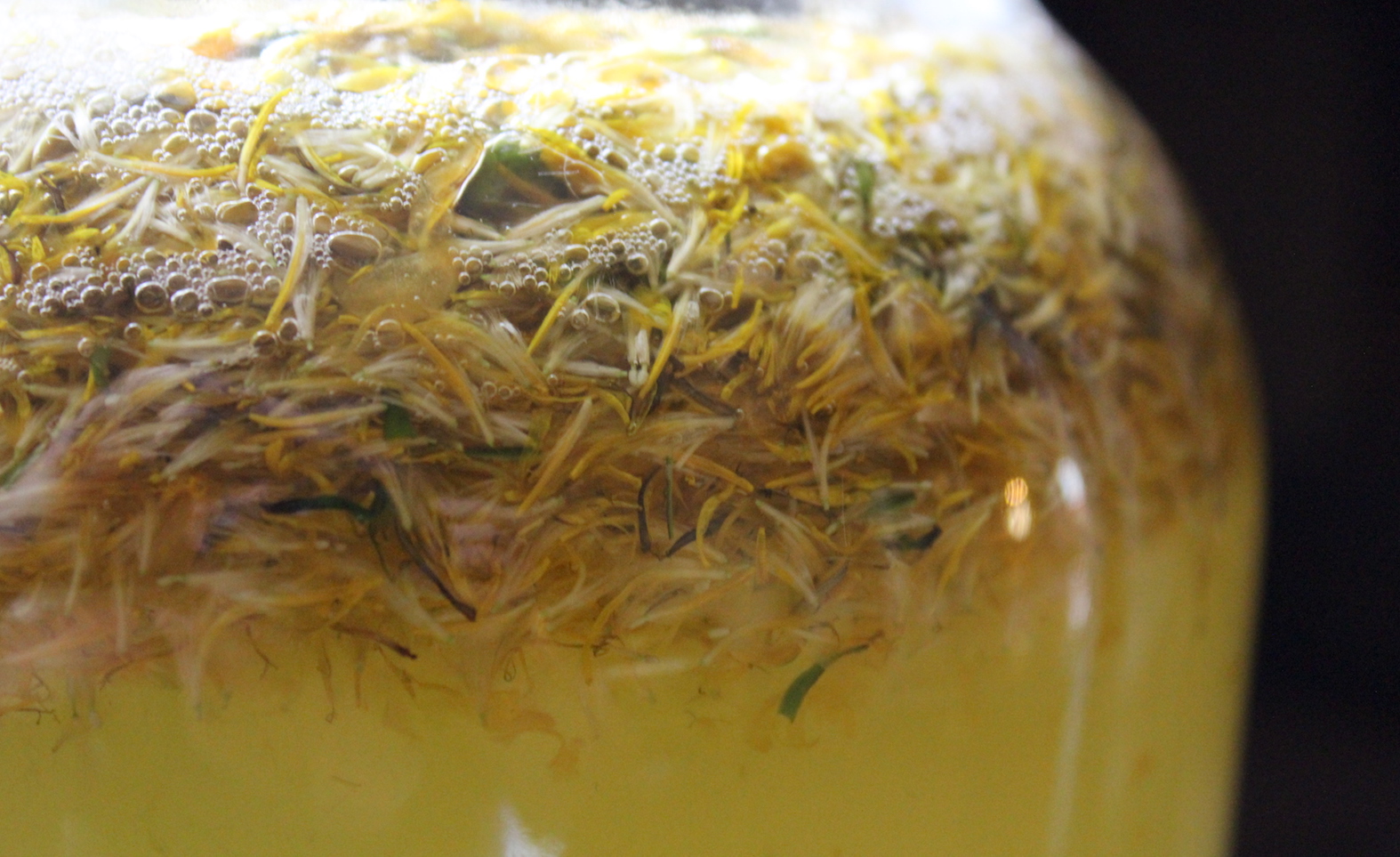
Primary Fermentation
For the first 7 to 14 days, the wine undergoes primary fermentation. During this stage, the yeast multiply rapidly, creating a lot of sediment at the bottom of the fermenter.
Since there’s little alcohol at this point, you don’t need to worry about sealing the fermenter with an airlock—just cover it loosely with a towel. While not strictly necessary, I prefer using a wide-mouth fermenter with an airlock, especially if you have pets or kids, as it helps keep contaminants out.
Racking
Once primary fermentation is complete, the wine needs to be racked (or moved) into a clean container. This is done using a siphon, which prevents disturbing the sediment (called “lees”) at the bottom.
If left in contact with the lees, the wine could develop undesirable off-flavors. At this point, you’ll filter out any remaining flowers and transfer only the liquid into the new container for the next stage.
Secondary Fermentation
After racking, the wine is transferred into a secondary fermenter and sealed with an airlock. This allows the carbon dioxide produced by the yeast to escape while keeping oxygen out, which is crucial to prevent the wine from turning into vinegar.
Secondary fermentation usually lasts about a month, although it can take longer depending on the recipe. For mead, this stage typically lasts 2 to 4 months since honey ferments more slowly than other sugars. During secondary fermentation, the wine should be kept in a cool, dark place at a temperature of 65°F to 68°F (18°C to 20°C), such as a basement or a back closet.
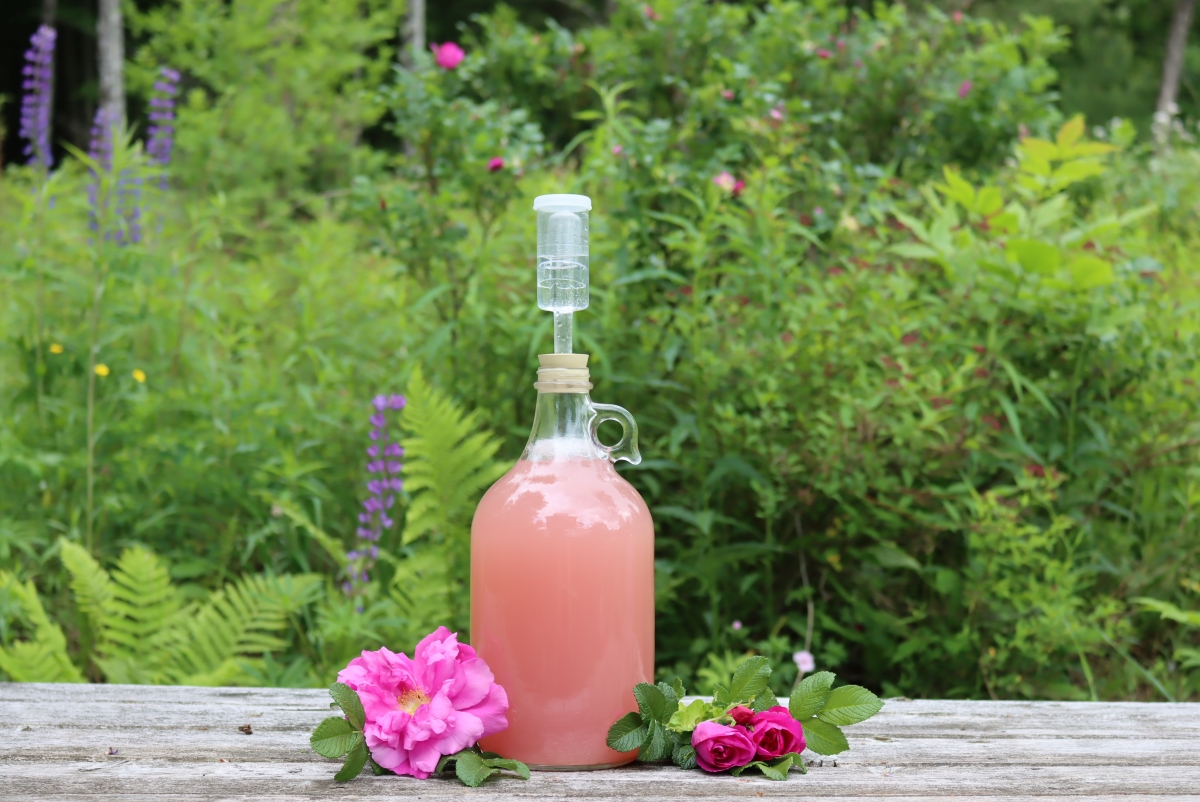
Tasting and Adjusting
After secondary fermentation, it’s time to taste the wine and make adjustments if needed. At this point, it will likely taste very raw and unrefined, but it should give you an idea of the flavor profile. If it’s too dry, you can add sugar or honey; if it’s too sweet, you may want to add acidity or pitch in a more vigorous yeast strain to consume the excess sugars. Sometimes, it may need more tannin or other adjustments; this is your chance to make any necessary adjustments.
If the wine tastes just right, you can move on to bottling.
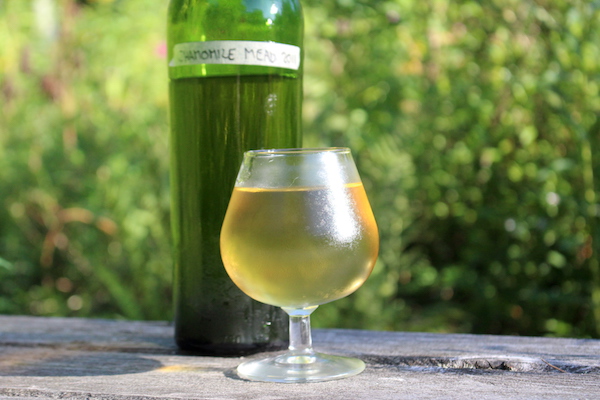
Tertiary Fermentation (optional)
If you’ve made any adjustments to the wine, it’s a good idea to rack it into another fermenter for a couple of weeks to allow any remaining sediment to settle out. This is known as tertiary fermentation.
Bottling
When you’re ready to bottle, use a brewing siphon to transfer the wine into bottles, then seal with corks. Some winemakers choose to sterilize the wine with potassium sorbate at bottling to prevent further fermentation in the bottle.
However, I don’t sterilize—by ensuring a long secondary fermentation, the yeast will have died off, and I’ll rack it into a tertiary fermenter if needed to ensure no further activity.
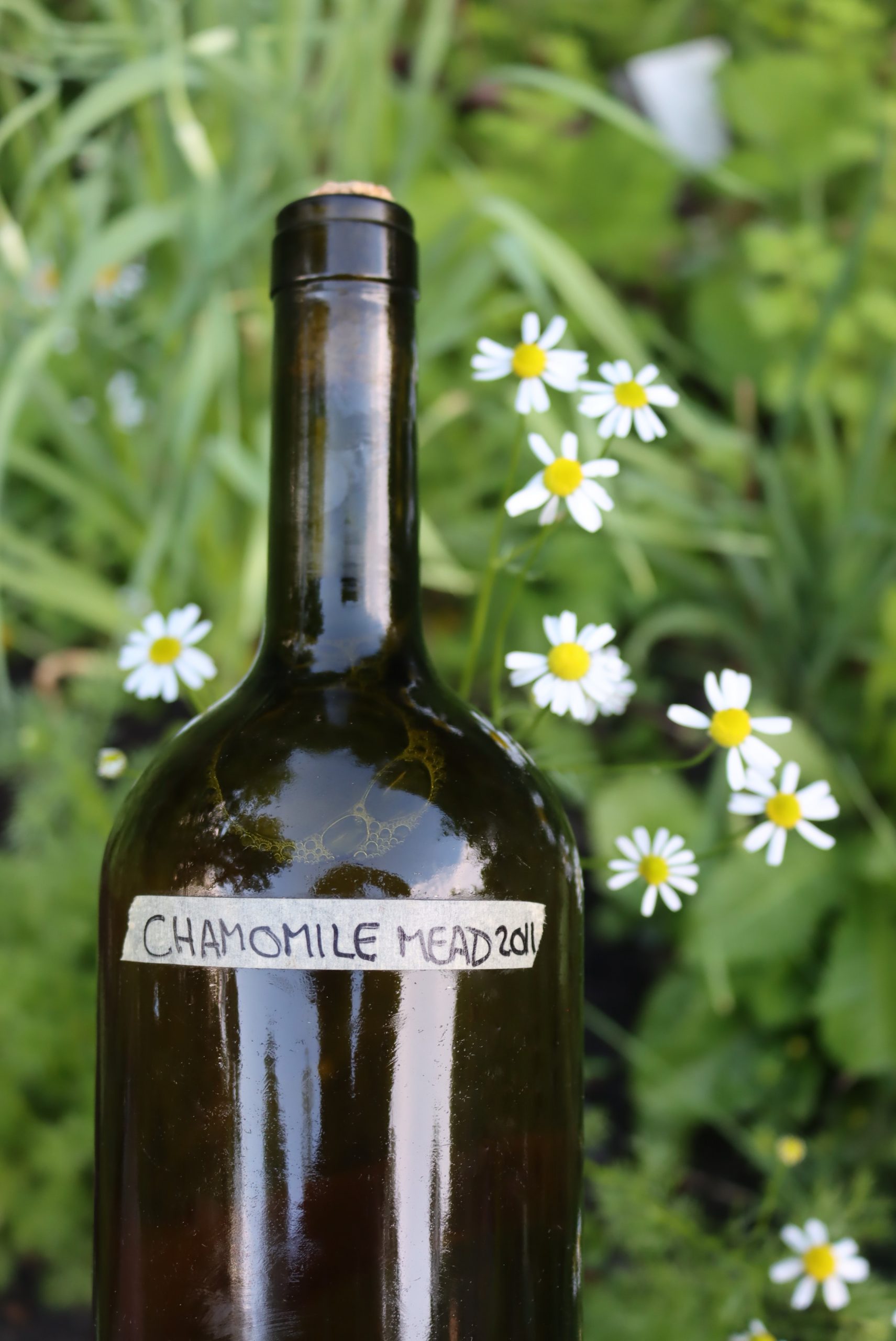
Flower Wine & Mead Recipes
I’ve included a basic recipe for flower wines and meads in the printable recipe card below. However, sometimes it’s helpful to follow a specific recipe tailored to the type of flower you’re using. Certain flowers have unique characteristics, and specific recipes can help highlight those flavors more effectively.
My lilac wine recipe, for example, includes a few blueberries for color and adds a bit more lemon juice so it comes out floral/fruity. Dandelion wine includes lemon and orange zest, to bring out the sunny flavor of dandelion petals. You get the idea.
In that case, take a look at any of these specific flower wine recipes:
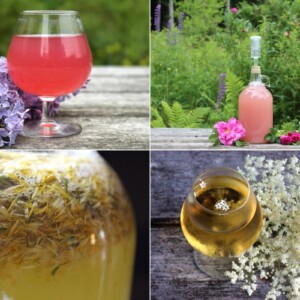
Flower Wine (or Mead)
Ingredients
- 1 to 4 cups edible flowers
- 5 to 6 cups sugar, or 3 lbs honey
- 4 to 6 cups white grape juice, optional, see note
- 1/4 cup lemon juice
- 1 tsp yeast nutrient
- 1/8 to 1/4 tsp tannin powder
- 1 packet wine yeast, see notes
Instructions
- Choose your base: Decide if you’re making a flower wine (with sugar) or mead (with honey). The ingredients for both are the same, with the only difference being the sweetener: use honey for mead and sugar for flower wine. For flower wine, you can improve its body by substituting part of the water with 4 to 6 cups of white grape juice, but this is optional. Mead, thanks to the honey, already has a naturally full body, so you don’t need to add grape juice. If you do use white grape juice, reduce the sugar by ½ to 1 cup.
- Prepare the sugar solution: Pour about half a gallon of water into a stockpot and bring it to a boil on the stove. Add the sugar (for wine) or honey (for mead), stirring until fully dissolved. Once dissolved, let the mixture cool completely before continuing. If you are using hot infusing, add the flower petals after removing the pot from the heat. For a cold infusion, add the petals directly into the primary fermenter.
- Infuse the flowers: If using a cold infusion, place the flowers into your primary fermenter, then pour the cooled sugar or honey-water mixture over them.
- Add remaining ingredients: Stir in the other winemaking ingredients (excluding yeast) and mix thoroughly.
- Add more water: Fill the fermenter with cool water to almost reach the top. For mead, you will need to add more water than for wine, as there’s no grape juice. Make sure the mixture is no hotter than 90°F (ideally at room temperature) before proceeding.
- Rehydrate the yeast: Once the mixture has cooled, dissolve the yeast in ¼ to ½ cup of room-temperature water and let it sit for about 10 minutes to rehydrate. Then, add the yeast mixture to the fermenter.
- Seal the fermenter: Top off the fermenter with water if needed to bring the level to the neck of the vessel. Seal the container with a rubber stopper and a water lock.
- Primary fermentation: Allow the wine or mead to ferment for 10 to 14 days, or until the fermentation activity slows down (primary fermentation).
- Rack the wine or mead: After primary fermentation, use a siphon to transfer the wine or mead into a clean fermentation vessel. Be sure to leave behind any sediment. Filter out the flower petals at this point. If you’ve been using a wide-mouth fermenter, now is the time to switch to a narrow-neck fermenter. Seal with a water lock and allow it to ferment in secondary. For wine, secondary fermentation should last 4 to 6 weeks; for mead, a minimum of 4 months.
- Bottling: Once fermentation has completed, bottle your wine or mead. If bottling wine, allow it to age for at least 2 weeks. For mead, wait a minimum of 2 months. While flip-top Grolsch-style bottles are fine for short-term storage, wine bottles are the best option for longer-term storage (more than 2 to 3 months).
Notes
- Red Star Cote des Blancs (Geisenheim Epernay): This yeast enhances the fruity character and sweetness in both red and white wines. It ferments slowly with minimal foam, which results in a longer fermentation period but preserves delicate aromas and volatile esters. Often used for apple wines, ciders, and sweet whites like Chardonnay, it has a lower alcohol tolerance—typically around 12-14%—especially at cooler fermentation temperatures, leaving behind more residual sugar. Its optimal fermentation temperature is between 64°F and 86°F.
- Lavin D47: Known for imparting a rich, fruity, and floral profile to wines, this strain adds complexity with notes of tropical fruit and citrus. It has a moderate fermentation rate and may start slowly. With an alcohol tolerance of up to 15%, it thrives in temperatures between 59°F and 86°F.
- Lalvin K1-V1116: This yeast is reliable in challenging fermentation conditions, such as fluctuating temperatures or low nutrient environments. It’s particularly known for producing a higher concentration of fruity and floral esters compared to other strains. K1-V1116 is ideal for rejuvenating bland or underwhelming juices. It boasts a high alcohol tolerance of up to 18% and can ferment in a wide temperature range from 50°F to 95°F.
Nutrition
Nutrition information is automatically calculated, so should only be used as an approximation.
Winemaking Recipes
Looking for more winemaking recipes?
Mead Recipes
How about a few more mead recipes?
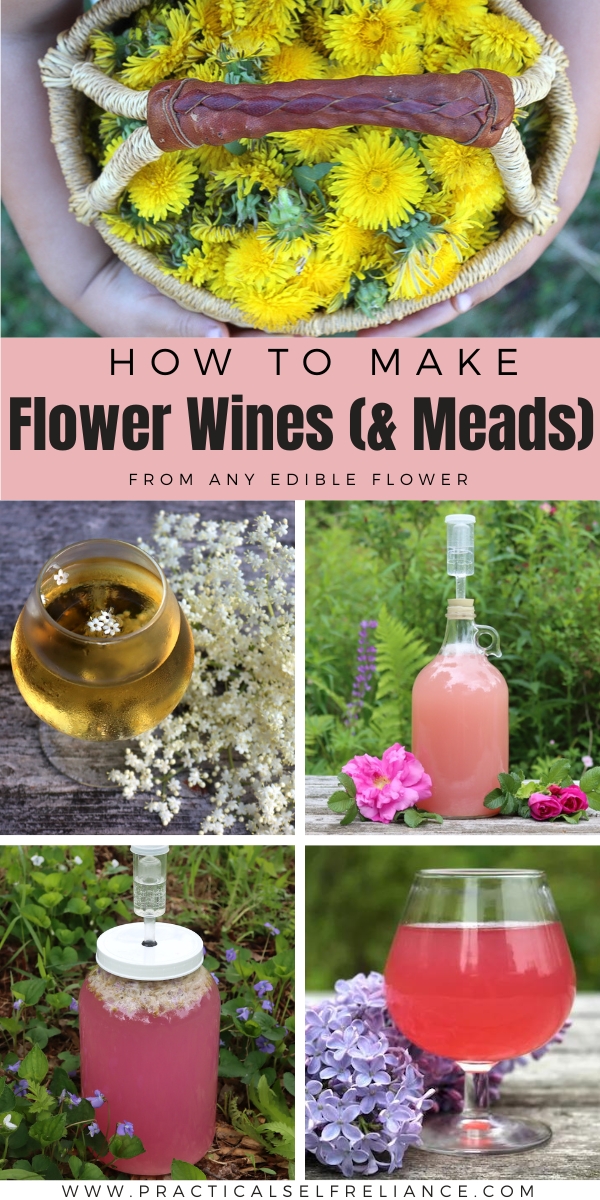


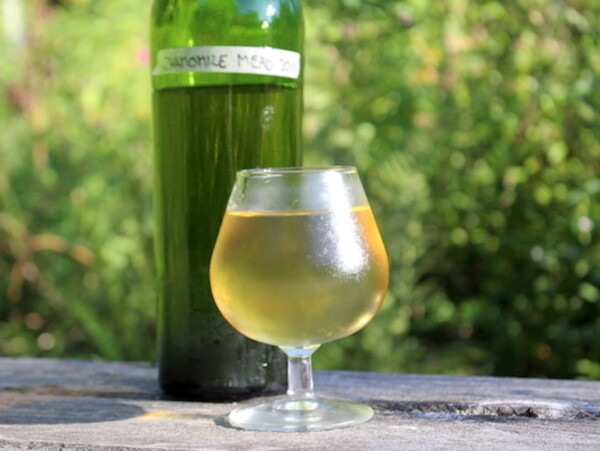
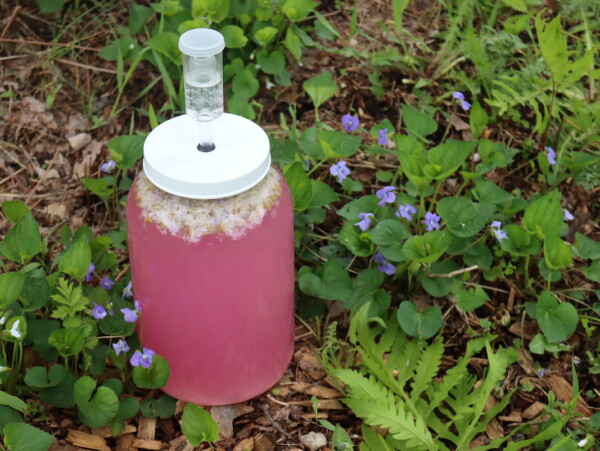
Video?
Sorry we don’t currently have videos for this.
Yes that clarify it thank you
Cheers
You’re very welcome.
When you refer to one cup to a quart do you mean a quart as in a quart jug or one cup of petals to one quart of water?
The amount of flowers used can vary. In general, you will use about a quart jar of flowers. If you’re using a more intense flower, a cup will usually do. Does that make more sense?
Hi, have you ever tried to make wine from lupines? They are so prevalent here in Maine and wanted to know if you think the petals would work for wine or if you had tried at any point. Thanks for the useful info! I enjoyed the read!
I haven’t personally tried them but you can make wine from any flower as long as it’s edible so why not give it a try? Just be 100% sure that the variety you are using is edible.
1